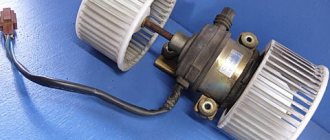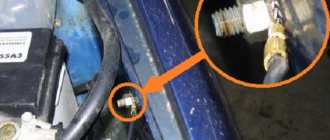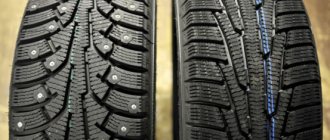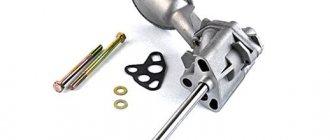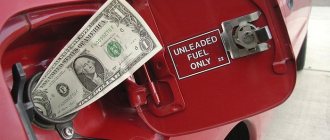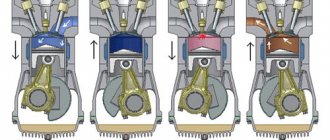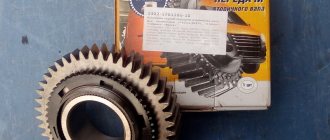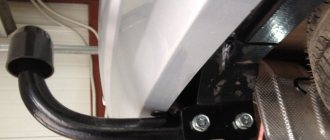Normally, the fuel pump emits a quiet hum when operating, which is drowned out by the engine. You can only hear it when you turn the key to the “start” position with the engine not running. At this moment the pump begins to pump fuel. If the fuel pump is humming at this moment, this means that it is intensively pressurizing the fuel system and if the sound stops after that, then there is nothing to worry about. In other cases, any noise, hum or whistle made by it indicates a malfunction of the fuel pump.
The fuel pump does not pump: reasons
If the fuel pressure is below the permissible level and the pump stops working, you need to figure out the reasons why the fuel pump is not pumping fuel.
If there is no noise from the pump, that is, it does not turn on when the ignition is turned on:
You need to check the 12 Volt power supply, the ground on the fuel pump chip. If the relay does not operate, add the electronic control unit “brains”. If there is no voltage, find and eliminate the cause in the vehicle's electrical circuit.
Next, if there is voltage and ground, check the integrity of the wires inside the pump; to do this, you need to remove it from the tank and disassemble it. A common occurrence on VAZ modules is burnout of the chip in the fuel pump housing. Then you have to change both the chip and the top connector on the module body.
If everything is in order here, but the engine does not start, connect 12 volts from the battery to the module and check the noise of the pump. If the fuel pump doesn't work, it's dying. Replace the fuel pump motor.
If the fuel pump works but does not pump gasoline, check:
- Rail fuel pressure
- Clogged pipelines, fine and coarse filters.
- Fuel pressure regulator for performance. It is located on the ramp or in the fuel pump module in the tank.
It is common for water in the tank to turn into ice in winter. Accordingly, the pump works, but does not produce the required pressure.
If the electric fuel pump works, then it doesn’t work:
- Disassemble the pump module
- Check the chip for contact burnout, as shown above.
- Check the relay and contacts on the brains.
There are times when the fuel pump stops working while driving. This is a very unpleasant situation, especially in the city, in traffic and traffic jams.
Other common problems
Engine noise may be temporary. If they occur when the tank is almost empty, this means that part of the filter in the tank in front of the pump is preventing the pump from filling and must either be replaced or cleaned. Remember that the electric pump is cooled by the fuel in which it is immersed, and the distance from it to the bottom of the tank is usually 1/4 of the total depth. The less fuel in the tank, the higher the load on the pump and constant driving with an almost empty tank will lead to its premature failure.
Checking the fuel pump
Checking the mechanical fuel pump
The operation of a mechanical fuel pump is checked by disconnecting the hose from the manual pumping outlet, after which the lever on the pump pumps fuel, which, if there are no breakdowns, should be supplied in a stream in time with the movement. During the procedure, place a rag under the pipe to prevent gasoline from spilling in the engine compartment.
Checking for faults in the electric fuel pump is carried out in the following ways:
Checking the filter on the electric fuel pump
1. Check the filter. Most often, problems with the operation of the device arise when the coarse filter is clogged, which is characterized by the appearance of the following symptoms:
- Decrease in engine power;
- Weak traction at high speeds;
- Difficulty starting the engine;
- Unstable operation at idle and low speeds.
Checking the fuel rail pressure
2. Checking the pressure in the fuel line, based on the results of which you can more accurately determine the problem with the pump:
- At idle speed the pressure should be 0.23-0.25 kPa;
- When starting the engine, the pressure should reach 0.3 kPa;
- In transition mode – 0.28-0.3 kPa.
If in transition mode the pump does not produce the required pressure, then there is a high probability of clogging of the coarse filter mesh. If the pressure in the fuel line when the return pipe is pinched does not reach 0.4 kPa, this means that the degree of wear on the pump is quite high.
3. Check the pump for mechanical damage. If the pump mechanism is significantly worn or dirt gets into it, a characteristic noise will be heard. When the ignition is turned on, the fuel pump works, but with obvious signs of a malfunction of the mechanism.
Mechanical fuel pump repair
Repairing a mechanical fuel pump consists of installing a new repair kit (diaphragm and valves) and, if necessary, a worn pusher with a spring. A deeper repair of this device is impractical, since the costs of purchasing and repairing worn parts are close to the cost of a new product. If the pump housing is deformed or damaged, it must be completely replaced.
Electric fuel pump repair
The electric fuel pump is equipped with a non-separable housing, and if it breaks down, the product is replaced with a new one. Without special skills, equipment and spare parts, opening and repairing it is impossible. But some workshops undertake similar work, the price of which is lower than buying a new pump. The main failures of the device are as follows:
- Damage to brushes and motor commutator. Repair involves replacing them with new ones.
- Breakage of the plastic coupling connecting the rotor and the motor armature shaft. The clutch is replaced with a new one.
- Anchor failure. The repair involves rewinding this part.
The described actions allow us to eliminate the gas pump malfunction on all models of the VAZ: 2101, 2102, 2103, 2104, 2105, 2106, 2107, 2108, 2109, 21099, 2110, 2111, 2112, 2113, 2114, Niva, Priora, Kalina, Grant, Vesta and most foreign cars.
Removal, disassembly, replacement
If after checking it turns out that the pump does not produce the required pressure, it is dismantled and disassembled. The submersible pump is mainly installed under the rear seat in the cabin. There is a hatch that needs to be opened and the device removed. On used cars, it is also recommended to flush the fuel tank, as harmful deposits can re-clog the parts.
The pump is disassembled in order to replace the mesh (coarse filter). After the mesh has been replaced or cleaned, the RTD is checked. This is a sensor mounted on the fuel rail. It regulates the pressure, and if it malfunctions, noise and whistling from the fuel pump may occur.
If the fuel pump itself is faulty, then most often it is a failure of the motor. It deteriorates due to low-quality gasoline, poured over a long period of time, or a short circuit. Signs of a faulty motor are identified by sudden changes in pressure, which can be recorded with a pressure gauge. And, of course, if the pump motor is faulty, the hum becomes as loud as possible.
In many cases, the motor itself must be replaced; it is not necessary to buy a new submersible pump. At the same time, it is recommended to replace gaskets and seals, which wear out over time.
If the device does not turn off and constantly buzzes, this indicates an electrical fault. Most likely, the circuit contacts are stuck or burnt, or a short circuit has occurred.
Video: fuel pump hums
Forget about fines from cameras! An absolutely legal new product - Traffic Police Camera Jammer, hides your license plates from the cameras that are installed in all cities. More details at the link.
- Absolutely legal (Article 12.2);
- Hides from photo and video recording;
- Suitable for all cars;
- Works through the cigarette lighter connector;
- Does not cause interference to radios and cell phones.
Normally, the fuel pump emits a quiet hum when operating, which is drowned out by the engine. You can only hear it when you turn the key to the “start” position with the engine not running. At this moment the pump begins to pump fuel. If the fuel pump is humming at this moment, this means that it is intensively pressurizing the fuel system and if the sound stops after that, then there is nothing to worry about. In other cases, any noise, hum or whistle made by it indicates a malfunction of the fuel pump.
Signs of a fuel pump malfunction
Mechanical fuel pumps
In a mechanical fuel pump, malfunctions most often occur due to wear of the sealing gaskets and the formation of leaks between parts of the housing. As a result, the tightness of the structure is broken, air gets in, fuel stops getting into the carburetor and the engine stalls. A similar consequence is caused by membrane rupture and valve failure. At the same time, the car begins to move jerkily until the fuel supply stops completely.
Electric fuel pumps
On cars with mechanical and electronic injection, the signs of a fuel pump malfunction are slightly different, but they can be classified into certain groups:
- The engine does not start. Rotation of the starter with dry spark plugs does not cause flashes in the cylinders. There is no pressure in the fuel line, or it is extremely low; the buzzing of the pump is not heard when the ignition is turned on or the starter is operating.
- The engine does not start, although occasional flashes occur in the cylinders. There is pressure in the fuel line, but without a pressure gauge its value cannot be determined. The candles are dry.
- The engine starts and idles normally, but pressing the accelerator causes it to stop. If you want, it is possible to raise the speed to medium, but attempts to start lead to the engine stalling. There is a black coating on the spark plugs, the operation of the fuel pump is characterized by a changing sound.
- The engine starts, holds idle speed normally, and picks it up easily at neutral speed. When driving at medium and high speeds, a “twitching” is observed. It happens that after a certain mark on the tachometer the speed does not pick up, and the engine stops producing the required power under load. At the same time, the spark plugs are white, and by their appearance it seems that the car is ignited too early or has a lean mixture.
It is worth noting that the above symptoms of fuel pump malfunctions are also typical for other engine breakdowns, and they cannot be used to unambiguously diagnose a fuel pump malfunction. For example, speed also fluctuates if there is a problem with the air sensor, throttle valve, clogged injectors or poor quality fuel.
How to avoid fuel pump failure?
In order to extend the life of the fuel pump or ensure an optimal operating environment for the new fuel pump (in case of replacement), you need to follow a few simple recommendations:
- do not allow the vehicle to be used for long periods of time with a minimum level of fuel in the gas tank;
- when replacing the fuel pump, be sure to replace the mesh filter with a new one;
- carry out regular maintenance of the car’s fuel lines and flushing the gas tank - there is no need to do this too often, but once every year or two it will not be amiss;
- at the first signs of loss of operating dynamics and doubts about the quality of the fuel used, it would be a good idea to flush the injectors;
How to check the pressure in the fuel rail of a VAZ 2114
In order to find out what level of gasoline pressure is maintained in front of the injectors, you need to find out where the TR is located, inspect the fuel supply hoses to the RTD and the “return” hose, that is, the hose through which excess gasoline is drained into the fuel tank. You will need to work with these tubes when measuring the gasoline pressure in the TR. In addition, you need to prepare the necessary tools and materials:
- a pressure gauge, for measurements it is best to take a mechanical one, with the least possible readings - 7-10 kg/cm2, because a pressure gauge with large readings will give a large error in measurements;
- a hose that can operate under high pressure, preferably fuel or oxygen, with an internal diameter of 8 - 9 mm
- 2 – 4 clamps for securing hoses
- screwdriver and pliers
- cap for twisting nipples in car tires
- a container, preferably wide, to collect fuel when it is drained into the TR
- rags
Measuring pressure in the fuel rail must be carried out in four modes:
- with the ignition on - in this mode the pressure should be at least 2.9-3.0 kg/cm2.
- in low speed or idle mode - pressure is not less than 2.5 kg/cm2.
- with the hose disconnected from the RTD - the pressure is maintained within 3.3 kg/cm2.
- with a pinched hose for draining excess fuel back into the tank - the pressure increases to 7.0 kg/cm2.
- when overgassing, it increases abruptly to three and then drops to two and a half atmospheres
After everything is prepared, you can start working.
- Insert a pressure gauge into one end of the prepared hose and secure the connection tightly with a clamp.
- At the fuel pressure fitting, located in the free end of the TP, opposite to the one on which the RTD is located, unscrew the plastic cap covering the nipple.
- Place an empty container to collect gasoline and press the cap to twist the nipples to release the residual pressure in the fuel rail;
- Without removing the container, unscrew the nipple using the same cap. The locking nipple is absolutely identical to those installed in car wheels.
- After this, put the free end of the hose prepared for testing onto the fitting. Before doing this, put a clamp on the free end.
- Tighten the clamp securely on the fitting, avoiding any leakage.
- Using a fuel pump, pump fuel into the TR.
- Turn on the ignition and use a pressure gauge to check the pressure created in the cavity of the fuel rail. It should be 2.9-3.0 kg/sq. cm., no less. If the readings drop to zero, it means the fuel pressure regulator or fuel pump check valve is faulty.
- The next step is an idle test. Start the car engine and check the pressure gauge readings. The arrow must be in a position of at least 2.5 kg/cm2. If in this mode a pulsation of up to 0.2 atmospheres occurs, then it is necessary to clean or replace the coarse filter in the fuel tank.
- Before measuring the pressure in the fuel rail to check the RTD, it is necessary to disconnect the vacuum hose coming from the intake manifold from it. The pressure should increase to 3.3 kg/cm2, a value of 3.0 atmospheres is also considered acceptable. If it does not change, or changes slightly, then, with a high degree of probability, the fuel pump in the fuel tank has failed.
- Finally, the pressure is checked with the return line turned off. To do this, use pliers to pinch the return hose running from the RTD to the fuel tank, through which excess gasoline is discharged. The pressure should increase to a maximum of 7.0 kg/cm2. A value of 6.0 atmospheres is considered acceptable, and anything lower indicates severe wear of the pump. Drop less than 4.0 kg/cm2. indicates a clogged fine filter or pipelines in this line.
The fuel system of a modern car is the most important line that feeds the internal combustion engine and ensures its performance. Its condition determines how efficiently and economically it will work, and sometimes the safety of the entire car depends.
Therefore, an important task for the motorist is constant vehicle prevention.
You need to take your car to a repair shop and pay 500 rubles. Or you can purchase a fuel pressure gauge and adapter for about 1,500 rubles and do this whole operation yourself. And you can also farm! More details below.
The video below measures the pressure in the fuel rail using a conventional tire pressure gauge:
Types of faults
There are several types of faults that most often occur with submersible water pumps.
Doesn't turn on
There are 4 possible reasons why the device does not respond to being turned on.
- Electrical protection. Modern products provide a protection function that operates on the principle of traffic jams on the electricity consumption meter. If unexpected loads or power failures occur, the protection is triggered automatically and stops the operation of the unit. It is recommended to start the mechanism again only after the reason for the operation of the machine has been determined.
- Damage to fuses. Fuses can blow due to wear and tear, but sometimes they fail due to external reasons. If there is a regular burnout, experts advise checking the integrity of the power cable, as well as its connection location.
- Cable damage. To check the power cable, the equipment must be removed, since most of the cord runs under water.
- Protection against dry running. In addition to electrical protection, submersible devices are equipped with a device that controls the level of immersion in the liquid. If the liquid level is insufficient, the device automatically stops operating.
Turns on but doesn't download
In a situation where the switched on mechanism does not supply water, there may also be 4 reasons.
- Shut-off valve. The simplest reason explaining the lack of water pumping is a closed shut-off valve of the device. In this case, turn off the pump, then turn off the shut off tap. Frequently starting the unit with the shut-off valve closed can cause damage, so it is recommended to check the valve before each start.
- Low water level. If the shut-off valve is open, the next step should be to check the dynamic water level and adjust the immersion of the apparatus to the desired depth.
- Check valve failure. If the check valve becomes clogged, it may “stick” and stop flowing water. In this case, cleaning the part or replacing it with a new one may help.
- Intake filter clogged. A clogged filter can also interfere with the flow of water into the system, so you should check its condition and, if necessary, clean the filter mesh.
Productivity drops
If the equipment begins to supply significantly smaller volumes of water, it is recommended to check several assumptions.
- Reduced network voltage. When the voltage is low, the device is not able to operate at full capacity.
- The riser pipe is clogged. As the permeability of the lifting pipe decreases, the performance of the mechanism drops noticeably.
- Clogged fittings in the water supply network. Valves and faucets in the water supply system can become clogged and prevent the fluid from flowing fully.
- Incorrect pressure switch settings.
Too frequent switching on and off
The problem arises when the equipment is paired with a hydraulic accumulator. Frequent switching on and off can occur for several reasons.
- The pressure in the hydraulic tank is too low.
- Rupture of rubber components of the tank.
- Incorrect pressure switch settings.
Pulsating water supply
A pulsating stream of water from the tap indicates a decrease in the water level in the well below the recommended level. In this case, the mechanism should be lowered to the calculated depth as quickly as possible.
The housing is leaking
When the seals wear out, the unit body begins to leak. The location of the leak is easy to detect by the appearance of drips and corrosion. If the seals are not replaced in a timely manner, the product may completely become unusable.
It buzzes, doesn't pump
The machine may make a humming noise but not dispense water for the following reasons.
- The impeller stuck to the device body due to the pump being stored “dry” for a long time.
- The impeller is jammed due to sand, silt, and dirt.
- Damage to the engine start capacitor.
- Low voltage in the electrical network.
Vibrates strongly
Severe vibration predominantly occurs in centrifugal pumps due to worn bearings or loose fasteners. The problem is solved by replacing parts and strengthening elements.
Doesn't turn off
The submersible pump stops automatically turning off if the pressure switch fails, or if the relay has incorrect settings.
Why does the fuel pump start to hum?
A modern gasoline pump is a complex technical device that also operates in an aggressive environment. During operation, the operation of the gas pump is influenced by many factors - the quality of the fuel, the current condition of the fuel lines, various impurities and deposits in the gas tank. All this can ultimately lead to deterioration in the performance of the fuel pump or complete failure. A striking example of a violation of the optimal operating mode is the moment when the fuel pump begins to hum. A sudden, uncharacteristic noise in the area of the fuel tank clearly indicates problems that require your attention and, often, a visit to a car service center. There are several reasons why excessive noise may occur during operation of the fuel pump:
- debris entering the working cavities of the gas pump due to clogging of the mesh filter and excessive amounts of contaminants inside the gas tank;
- drying out of the lubricant on the moving elements of the pump due to frequent overheating (this happens if the car is constantly operated with a low level of fuel in the tank);
- obstruction of the fuel line due to clogging or mechanical damage;
- critical level of fuel injector clogging;
- failure of the pressure regulator in the fuel rail.
Sometimes it happens that a completely new fuel pump starts to hum. Here, first, we need to note one nuance. Gasoline pumps from different manufacturers, although they solve the same problem, may have some variation in performance characteristics. One of these characteristics is the level of noise produced. There are no standards that would regulate this parameter. And this, in a certain sense, frees up the hands of manufacturers - each of them limits the noise level at their own discretion. Some pumps make more noise, some less, but all this should happen within reasonable limits and not cause inconvenience to the driver and passengers of the car.
Repair
Mechanical fuel pump repair
Repairing a mechanical fuel pump consists of installing a new repair kit (diaphragm and valves) and, if necessary, a worn pusher with a spring. A deeper repair of this device is impractical, since the costs of purchasing and repairing worn parts are close to the cost of a new product. If the pump housing is deformed or damaged, it must be completely replaced.
Electric fuel pump repair
The electric fuel pump is equipped with a non-separable housing, and if it breaks down, the product is replaced with a new one. Without special skills, equipment and spare parts, opening and repairing it is impossible. But some workshops undertake similar work, the price of which is lower than buying a new pump. The main failures of the device are as follows:
- Damage to brushes and motor commutator. Repair involves replacing them with new ones.
- Breakage of the plastic coupling connecting the rotor and the motor armature shaft. The clutch is replaced with a new one.
- Anchor failure. The repair involves rewinding this part.
The described actions allow us to eliminate the gas pump malfunction on all models of the VAZ: 2101, 2102, 2103, 2104, 2105, 2106, 2107, 2108, 2109, 21099, 2110, 2111, 2112, 2113, 2114, Niva, Priora, Kalina, Grant, Vesta and most foreign cars.
Electric fuel pumps
Here the system is more complex, because there are two types: submersible devices placed in the tank, and remote ones, fixed separately. Both are powered by an electric motor located directly in the pump. How to check the fuel pump?
Voltage
Take a regular tester, or if you don’t have one, a car light bulb with the wires attached. Now you need to detect your device. If the fuel pump is remote, it is located somewhere near the tank. If submersible, look for the output terminals (usually they are under the rear seat). Further:
- turn on the ignition;
- touch the voltmeter probes or wires from the lamp to the contacts;
- if the device readings correspond to 12-12.5 volts or the light comes on, it means that voltage is supplied to the pump.
Wiring
Assessing its condition is easy: take a pair of long wires and connect directly to the pump. If it “squeals”, consider that the cause of the malfunction has been found. And if not? Go ahead.
Fuse
Everything is clear here: you need to find where it is and replace it, or insert a bug. If the fuse blows, the problem is most likely related to the positive wire going to the fuel pump, which shorts to ground.
Relay
To find it, read the labels on the fuse box cover. Pull the part out of the socket. Just in case, you need to check the serviceability of the relay with the battery terminals removed. Wind a wire onto its plus and connect it to two points of the relay: “85” and “30”. Connect the negative electrode to the light bulb contact and the relay terminal “86”. The second wire from the lamp must be connected to pin “87”. If the lamp lights up, the relay is working properly.
If you have a multimeter, connect its probes to terminals “85” and “86”. An infinitely high resistance indicates a winding burnout. But what to do when you find that the relay’s performance is zero, and there is nowhere to purchase the part? Just bridge its contacts “87” and “30”.
How to check fuel pump pressure
It happens that the device works, but the engine does not start. In this case, you need to check the pressure, which should be from 2.5 to 3.2 kg/sq.m. cm (check the operating instructions for your machine). When you press the accelerator, it rises by an average of 0.5 kg/sq.m. see. If this is not possible, try inspecting the coarse filter. To remove it, if the pump is a submersible type, remove the hatch by unscrewing the bolts. Next, check the fuel pipes for fuel leaks. Finally, replace the fine filter.
To check the pressure, you will need a pressure gauge with a special device installed between the fitting and the line. This can be done using two pieces of rubber hose that can withstand pressure up to 7 kg/sq. see. There is an important nuance: the pressure shown by the pressure gauge must remain at the same level for tens of minutes. If it drops earlier, there is a leak or wear on the pump valve. If the pressure decreases quickly, the engine will run unstably. There is another option for connecting the pressure gauge: directly under the hood, using a hose connected to the fuel rail. To measure the pressure, you don’t have to start the engine: just turn on the ignition and look at the pressure gauge readings.
It is worth recalling caution: there may be residual pressure in the hose. Therefore, take a clean rag and cover the fuel pump fitting with it before removing the pressure gauge so that fuel does not get on you. https://www.youtube.com/embed/F-EedE_tfpI
Electric motor
If everything is checked, there is voltage, but the pump does not work, the problem is most likely a burnt-out stator winding of the electric motor. Its serviceability can be checked with the same tester. To do this, disconnect the wires from the fuel pump and put the device in ohmmeter mode. Its probes must be connected to the contact terminals of the device. The tester should show some kind of resistance (it is different for each pump model). If the multimeter stubbornly shows “infinity” in all measurement ranges, you will have to buy a new fuel pump.
How to care for an autonomous heating system
Autonomous heating requires constant attention. Emergency repair of a circular pump will cause a lot of inconvenience.
- Connections and joints must be waterproof.
- Gaskets and bearings contain sufficient lubricant.
- A special device will help evaluate the connection and compliance of the electrical network.
- A test run will identify extraneous sounds and problems with the system in advance. The engine must operate without vibration and noise.
- Prolonged downtime is harmful to the pump. During the warm season, it is necessary to turn on the system once a month for 15-20 minutes.
- Starting the device without water in the pipes will lead to serious damage. It is also necessary to ensure normal fluid circulation and do not close the valves near the pump.
- The filter must be free of contamination. In its absence, only clean water is poured into the system.
- Limescale deposits interfere with the operation of the shaft. It must be removed periodically or try to use a less hard liquid for the device.
The hum of a submersible pump: when to be wary
In fact, this is the normal state of pump operation that occurs after turning the key in the ignition switch. While the pressure required for normal fluid supply throughout the line is being created, a quiet buzzing and humming noise is inevitable. However, this process lasts no more than 3-4 seconds, after which the relay is activated.
The main thing is the volume of the buzzing motor. If it is high, and when you turn the key in the lock it also whistles, this is a reason to think about it. As a rule, this happens more often on used cars, on which the service life of the parts is already coming to an end. Timely diagnosis will help identify problems at an early stage. In parallel with this, there may be an increase in fuel consumption, difficulty starting, “dullness” of the accelerator pedal and other problems. However, in general, the car has not yet lost its former dynamics, and you can drive with a “noisy” pump for more than one thousand kilometers.
But an increasing whistle and hum should alert the driver. As a rule, this indicates that the coarse filter is dirty. But other reasons are also possible.
- Contamination of the entire fuel line or part of it.
- Damage to the pump motor.
- Nozzles clogged.
- RTD malfunction.
Typical breakdowns of pumps of different brands
Equipment from popular domestic and foreign brands has its own characteristic failures. Devices from the Danish manufacturer Grundfos, despite their reliability and durability, require regular replacement of the mechanical seals. If this is not done in a timely manner, water will penetrate inside and damage the winding.
It is not advisable to service the unit at home. The specific design requires that repairs be carried out by an experienced specialist, ideally an employee of a company service center.
A pronounced hum and pressure that has dropped to a minimum indicate that the impeller in the pump has worn out or has moved along the axis. The device must be disassembled, cleaned of sand, damaged elements replaced and new seals installed.
Gilex units often leak fluid from the electric motor. It can be replaced, but only with a similar composition.
Some craftsmen believe that it is not necessary to buy an expensive substance. You can get by with glycerin or transformer oil. However, this is not the best advice. The equipment does not tolerate filling with alternative means very well and can completely fail after such an operation.
It is better not to repair the device yourself, but to entrust this task to qualified specialists. They are guaranteed to fill the engine with the original composition and do so in strict accordance with the manufacturer’s wishes. After servicing it will work just as well as on the first day of purchase.
Worn seals are indicated by a low oil level in the pump motor. It is better to replace them as quickly as possible. This will protect the motor from overheating
In the “Malysh” devices of the Russian enterprise Livgidromash, coils often fail. Dry work provokes this problem. A strong noise heard when turned on without pumping out water indicates a break in the central axis to which the membranes with the anchor are attached. This breakdown is easy to detect after disassembling the unit.
Replacing an axle even at home is not difficult. But finding a part on sale is really a problem.
Aquarius pumps tend to overheat. This drawback is especially active when the equipment operates in shallow wells. Repairs are expensive and sometimes amount to about 50% of the original cost. In such cases, many users prefer to buy a new device, albeit from a different manufacturer.
The same problem is typical for the “Rucheek” models. Despite the modern design and compliance with current European standards, they do not tolerate continuous operation.
The manufacturer says that the devices can continuously pump water for no longer than 7 hours. However, almost always such a load leads to overheating. To avoid problems, it is better to take breaks and let the equipment rest every 2-3 hours. In this way, the service life of the pump can be extended.
Do not start water pumping devices with the shut-off valve closed. In the future, this will lead to breakdown of pumping equipment. Before turning on, the valve must be opened
Vodomet pumping equipment is considered to be quite reliable and operationally stable. Most breakdowns here occur due to improper use. Also, when equipment comes into contact with contaminated water, it quickly becomes clogged with silt and sand. In this case, the pump part of the unit requires replacement.
When a problem cannot be solved at home, you should seek help from the professional technicians of a certified service center. They will quickly determine what happened to the equipment and restore its functionality. Or they will recommend purchasing and installing a new pump if the old one cannot be repaired or it is not economically viable.
Electric fuel pump for a motor with a carburetor
So, an electric low-pressure fuel pump on fuel-injected cars is located in the gas tank and takes fuel from the fuel tank, after which it supplies it under a certain pressure to the injectors. As a result, the engine operates stably regardless of the load, and accurate and timely injection is also achieved.
In both the first and second cases, the pump supplies fuel to the metering systems (injectors or carburetor). It is quite obvious that if you install an electric pump instead of a mechanical pump, you can achieve trouble-free operation of the carburetor and a stable fuel supply.
However, it is important to understand that the electric fuel pump on the carburetor must operate at low pressure to avoid fuel overflow. As for the installation itself, in some cases the electric pump is installed under the hood, and not in the tank (as on an injector)
Also quite common is the option when the pump section is integrated directly into the gas tank.
Installing an electric fuel pump on a carburetor
Let us immediately note that installing an electric fuel pump on a carburetor internal combustion engine is associated with a number of difficulties
Please note that without proper experience in carrying out such work, it is not recommended to carry out the specified modifications to the fuel system yourself.
Now let's look at a common installation method with an example. First of all, you need to select the most suitable electric fuel pump in terms of performance for the specific type of internal combustion engine and the carburetor installed on the car.
In addition to the pump, you should also prepare the following items:
- hose 5 meters long, internal diameter of the hose is about 8-9 mm;
- an additional relay will be required;
- you also need to have a 3 or 4 mm drill;
- you will also need a fuel filter from injection systems;
- fuel filter for carburetor systems;
- steel tube 7 mm with a wall of 0.8 mm and a length of 25 cm;
- fuel hose with an internal diameter of 12 mm;
- adapter fitting from 8 mm to 12 mm;
Having prepared everything you need, you can proceed to installation. First you will need to remove the fuel level sensor in the gas tank. Then a hole is drilled in the sensor cover, then a 7 mm tube is soldered into the hole with a soldering iron
It is important to bend the tip of the tube so as to drain the return as far as possible from the fuel intake
Also, the upper end of the tube is bent parallel to the outlet of the fuel intake. Now a modified fuel level sensor with an intake and return should be installed in the tank. It should be taken into account that the rubber tube will need to be connected to the installed return fitting from the standard fuel line.
Now one end of a hose with a length of 5 meters is put on the fuel intake fitting. After the rubber fuel supply hose has been connected, the said hose is securely attached to the metal tube. This can be done by using clamps.
When installing, it is important to ensure that the pump is positioned correctly (fuel is sucked in from the side of the expansion tank, and the supply goes to the engine). Next, a fuel filter from the injection systems is installed on the rubber supply hose.
A hose 5 cm long should be put on the second fitting. This hose is subsequently secured with clamps to the car body in a vertical position.
This is necessary so that fuel is supplied from bottom to top. The electric fuel pump itself is connected to the gas tank using a 12mm hose. A steel adapter is used for connection. At this stage, the pump connection can be considered complete. Now we need to deal with the issue of pressure of the new pump, which is higher than that of a mechanical one. If the pressure is high, the carburetor will flood.
To solve the problem, modifications will be required. First of all, the top cover is removed from the pump, the supply fitting is unscrewed, and then the mesh is removed. Next, the hole is drilled 1-3 mm with a pre-prepared drill. Now all that remains is to complete the final assembly, connect the fuel pump through a hose, installing a fuel filter for carburetor systems in parallel. For this, a rubber tube is used, fixation is achieved using clamps.
As for the power supply to the pump, the device is connected via a power relay to the 12 V contact, which is located on the ignition coil.
content .. 26 27 28 29 ..Lada VAZ-2110 (2111, 2112). Why is the fuel pump humming?
The electric fuel pump on cars with an injector is a submersible fuel pump that is installed directly in the gas tank. Structurally, such a pump is an electromechanical device that takes fuel from the tank and supplies it to the engine. The task of the fuel pump (BN) is to pump fuel into the fuel line. As a result, the necessary pressure is created in the fuel rail for subsequent injection of gasoline using injection nozzles.
The list of common faults includes the following:
- the fuel pump hums/whistles; - the fuel pump gets very hot; - the fuel pump does not turn off;
Let's look at the main reasons why these problems occur, and also consider the available ways to check the fuel pump yourself.
The fuel pump whistles and hums
Let's start with the fact that the proper operation of the fuel pump involves a certain noise or soft humming sound after turning the ignition key. In other words, the fuel pump hums while it creates operating pressure in the line. This process lasts 2-3 seconds, after which the driver can hear a slight click. This click is produced by the fuel pump relay.
Note that many drivers of cars with mileage of 100 thousand km or more. and more note a slightly increased noise level from the fuel pump. The fuel pump may hum or whistle louder when you turn the ignition key. At the same time, there are no problems with engine starting, fuel consumption and smooth reactions to pressing the gas pedal while driving. The car practically does not lose any dynamics, allowing you to drive with a humming gas pump for tens of thousands of kilometers.
In case of such pump problems, it is advisable to carry out diagnostics, since constant operation with an increased load causes overheating of the fuel pump and reduces its service life. However, you should not immediately change the pump without checking it. Replacing the fuel pump mesh and fuel filter, as well as cleaning the injectors, in many cases allows you to get rid of noise. A stronger or progressive whistle and hum of the fuel pump is a reason to immediately identify and eliminate the breakdown, which involves checking the functionality of individual elements of the engine power system. In this case, increased noise level of the fuel pump usually occurs for the following reasons:
dirty fuel filter and fuel pump strainer; the fuel line is clogged; the fuel pump motor fails; fuel injectors are clogged; the pressure regulator in the fuel rail is faulty;
These malfunctions are also often accompanied by poor engine starting, unstable operation of the internal combustion engine (the engine troits) at idle and under load. There were jerks, dips and delays in the engine's response to pressing the accelerator. In such a situation, the car becomes difficult and even unsafe to operate, since you can suddenly stall or get into an emergency situation when trying to overtake.
The fuel pump is very noisy: troubleshooting
In most cases, an increase in noise level occurs due to an increasing load on the gas pump, which becomes more difficult to pump the required amount of fuel. Overheating or failure of the pump itself is less common.
At the initial stage, it should be understood that if the gas pump makes a sound (albeit different from normal), then power is supplied to the device and the pump itself reacts to the supply of electricity. Based on this, the problem can be localized faster. Before diagnostics, it is recommended to replace the fuel filter to eliminate the possibility of a decrease in throughput in this area.
To start checking the fuel supply pump, you need to measure the fuel pressure in the fuel rail with a pressure gauge. The average pressure is considered to be 3 atmospheres. This method allows you to accurately assess the performance of the fuel pump. There is also a simple solution that allows you to quickly check the status of your device. The method involves removing the return hose and inserting it into a separate container suitable for pouring gasoline. Next, you need to measure how much fuel is drained back into the tank. The norm for many gas pumps is a minimum value of 1.5 liters per minute or more. The disadvantage of such measurements can be considered very approximate readings, which do not allow obtaining accurate data.
If the check shows that the pump does not produce the required pressure or constantly works to maintain it, then you need to change or clean the fuel pump strainer. To do this, you will need to remove the fuel pump, which is usually located in the rear of the car under the seat. Please note that on cars that have been in use for a long time, in parallel with replacing the mesh, it is necessary to wash the gas tank itself. The fact is that dirt and deposits will quickly damage the new filter.
After replacing or cleaning the pump filter, you should also check the pressure regulator in the fuel rail and clean the injection nozzles. In most cases, these procedures can reduce the noise level or almost completely eliminate the whistling and hum of the fuel pump. If the pump continues to make noise, then there is a high probability that the pump motor needs to be replaced.
Replacing the fuel pump motor
The reason for replacing the fuel pump module motor is low gasoline pressure or sudden changes in pressure, which is recorded by a pressure gauge during the diagnostic process. Also, the imminent failure of the motor is indicated by the fact that the fuel pump is humming or whistling.
In this case, it is often possible not to change the pump assembly, which will save money. The device must be removed (similar to the situation with cleaning or replacing the mesh filter), after which it is disassembled. The motor itself is replaced and can be purchased separately. The housing and fuel level sensor can be left from the old fuel pump. At the same time, it is recommended to replace the gas pump gasket and other rubber seals, which are not designed for re-installation after removal, that is, they are disposable.
The fuel pump does not turn off and overheats
One of the common malfunctions is that after turning the ignition key, the fuel pump does not turn off, that is, it hums constantly. In the list of the main reasons, auto electricians highlight:
burning (sticking) of the contacts of the controlled circuit of the fuel pump relay; short circuit in the electrical wiring to the pump; Less commonly, a malfunction of the ECU or the pressure sensor on the pump occurs (which depends on the fuel pressure device of a particular vehicle), which also forces the fuel pump to work constantly. Another reason could be injectors that are “pouring”, which does not allow the pump to create pressure in the rail and start the engine. You can check the condition of the spark plugs. If the spark plugs are flooded, then you should check the injector chain for a break.
The fuel pump relay is quite easy to check. A working element in a working system clicks after 3-5 seconds. after turning on the ignition, after which the pump turns off. If the relay does not make a click or there is a click but the pump does not turn off, then you need to remove the relay. Stopping the pump will indicate that the specified relay has failed. You can also take out the relay and lightly tap it, while simultaneously removing the terminal from the battery. This method often solves the problem of a stuck fuel pump relay. Now a few words about pump overheating. If the fuel pump on the injector overheats, this manifests itself in a decrease in its performance and unstable engine operation. The electric fuel pump itself is submersible, that is, it is located in the fuel tank directly in the gasoline. This arrangement allows the device to effectively cool itself in the fuel. A low fuel level below 1/4 tank during active vehicle operation in high outside temperatures can cause such overheating.
content .. 26 27 28 29 ..
Preparatory work
Products are checked for defects. External characteristics are assessed: the pipes should not have dents, cracks, bumps or stains. It is recommended to use communications characterized by a smooth wall surface. You can lightly tap the products. The sound should be the same in different places. The condition of the cut is also assessed. Its structure should be uniform, fine-grained.
If you plan to replace cast iron pipes, you must first dismantle the old communications. For this purpose, prepare a hammer (for horizontally oriented products) and a grinder. The riser is cut only using a grinding machine. It is not recommended to use a hammer in this case, since individual parts may fall into the lumen of the pipe, which will lead to a blockage that is difficult to remove. Before installing communications, it is necessary to shut off the water riser. If the toilet connection is changed, you should not use the flush for some time.
This is interesting: How to remove air from heating pipes?
